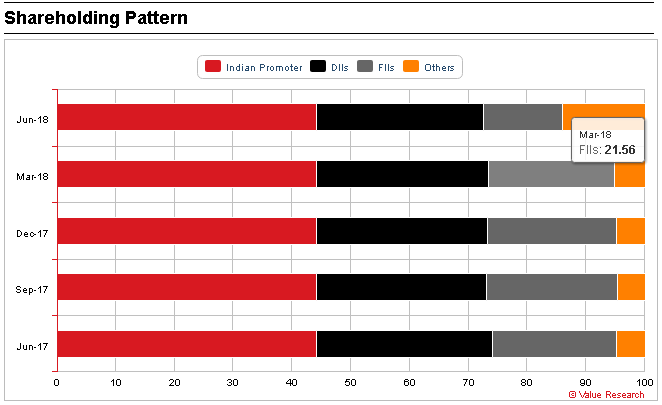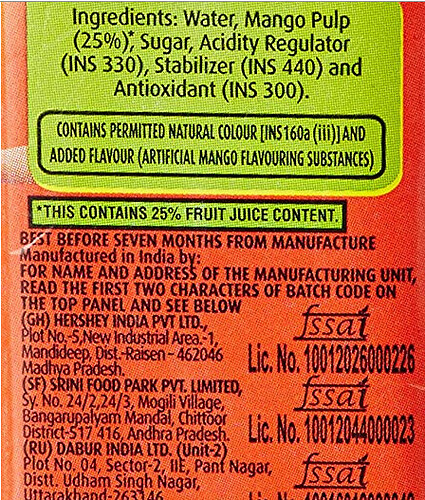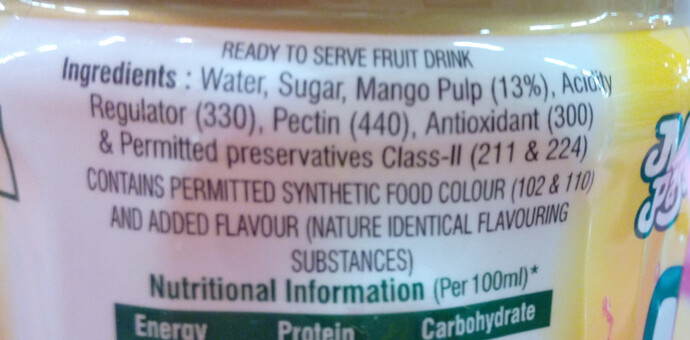While FII exodus from India would be terrible, but it may not be like this…this is a case of total lost of trust company and not good management company facing exodus…bottomline if company is excellent it will find investors in some other country or institution…a country level event would mean country has lost trust…if that happens then in any way something very bad has happened any stock markets worry would be smaller than the main event…
We can be cautious when investing but we need to think positive for country level…if such bad event happens then will banks be able to pay FD interest and government PPF interest? Will our jobs remain…will our business, if any, survive…and house prices will crash as no buyers…therefore best we can do is focus on good bsuinesses and trust things will be better at country level 
Elantas Beck India fell 83.4% from Apr 2012 to Sep 2013.
It used to have a MCap of 1700 Cr at that time, same as of now.
Its PE was ~ 55 before the fall (Dec 2011 earnings) and became ~ 14 (Dec 2012 earnings).
I am not aware of the reason behind that fall, but EPS fell from 30.49 to 19.86 from Dec 2011 to 2012. It was 40.11 on Dec 2010.
https://www.screener.in/company/500123/
This is old ratings of Manpasand though not that old… But Crisil also said 4.5% Market share which is close to what actually people are expecting…
At 4.5% Market share of total 7-8K crore mango drink market …for FY17 … I don’t feel that revenues are shown more or hyped…
What about this rating?
Believe it or not “Every letter needs to be signed by a biological person” doesn’t happen anymore in more advanced countries. Times are changing. 
The answer lies in first two lines of the document itself.
CRISIL has withdrawn its rating on the proposed long-term bank facility of Manpasand Beverages Limited (MBL) at the company’s request. The company has confirmed that it has not availed any debt against the facility.
Manpasand did not need any credit against the rating. So, they asked Crisil to withdraw it.
Withdrawing rating is also a possible euphemism for future credit downgrades. Credit rating agency regularly communicates with company and sometimes lets it know that future actions may be negative. Company can then decide it’s not worth having a credit rating. Credit rating agency is absolved of all responsibility once a rating has been withdrawn.
In short, about Vakrangee(1) and Manpasand(2), Latest Holdings Status
(1) Retail investors more than doubled their stake in Vakrangee to 10.55 per cent at the end of June quarter from 4.63 per cent and 4.16 per cent at the end of March and December quarters, respectively.
Foreign portfolio investors (FPI) also reduced stake in Vakrangee to 20.55 per cent from 29.12 per cent at the end of March.
Mutual funds held just 42,051 shares of Vakrangee as of June 30 against nearly 5 lakh at the end of December quarter.
(2) Retail investors’ with share capital of up to Rs 2 lakh hiked their stake to 6.19 per cent during the quarter gone by from 2.49 per cent at the end of previous quarter.
Foreign portfolio investors reduced their holding to 13.35 per cent from 21.56 per cent.
Mutual funds reduced their holdings to 10.83 per cent from 11.60 per cent at the end of previous quarter.
To summarize, for Manpasand, FPIs reduced stake by 30%, and MFs reduced stake by 6.5%. Retail absorbed these stakes. MF reduction is negligible, given 60% reduction in price. Reaction seems relaxed, or at least waiting rather than panic selling.
Discl: 2% stake in portfolio @ average price of 150, invested since past week.
Went to DMart (in Bangalore) and saw they have come out with their own mango drink - Mango Merry. Packaging is very similar to Mango Sip.
In many forums and posts about Manpasand, we hear that smart money is dumping and retail is absorbing it stupidly. I have just one question. What sorts of smart money are they who buy at Rs 450-500 and sell at Rs 150?
They are smart by saving whatever is left… Even if they had invested in IPO , they are not loosing anything except opportunity cost from 2015-18
For retail it becomes Hero-Zero game… We know everything what has happened and still we are emotional…we invest without any proof justifying ourselves that no…we can see so many shops selling it … This has to be true brand…
Well…Well…Well… Retailers can win this…by luck but FPI is losing nothing again…they find some other share …
Because domestic MFs knows our companies better than FPIs and if they don’t sell it this quarter then… Manpasand Beverages will stabilize and lack supply…
Its a question which time only can answer, whether retail is walking into a trap or FPIs over-reacted. I mean Delloite has signed their balance sheet for 7 years without even adverse qualification. So how probable is it that the promoter who was honest for 7 years turned a crook in the 8th? Its often compared with Vakrangee but their business models are vastly different. I tried hard to find out how Vakrangee can make so much money but could not find a plausible explanation. In Manpasand’s case, one can see product visibility in trains and also in retail stores.
In India, far more listed businesses have gone down under due to leverage than due to corporate governance.
Disc. Invested a bit around Rs 135, less than 0.5% of PF.
Word of caution: I’m pretty new at analyzing businesses, but trying to put
forth my analysis.
Let’s start with these numbers:
Part 1: Piotroski F Score breakdown
| Piotroski Score | 2 |
|---|---|
| Positive ROA | Y |
| Positive CFROA | N |
| Higher ROA yoy | N |
| CFROA > ROA | N |
| Lower Leverage yoy | N |
| Higher Current Ratio yoy | N |
| Less Shares Outstanding yoy | N* |
| Higher Gross Margin yoy | Y |
| Higher Asset Turnover yoy | N |
2-3 is a bad or low score. The Piotroski score highlights Part 2 and Part 3
as well, but just wanted to see where else this business isn’t doing well.
According to Professor Joseph D Piotroski, such a score makes it a great
shorting candidate.
* Yet to account for any additional share dilution.
Part 2: Declining ROE, ROIC, and ROA
| Year | 2014 | 2015 | 2016 | 2017 | 2018 |
|---|---|---|---|---|---|
| ROIC | 16.44 | 16.45 | 11.27 | 10.22 | 9.97 |
| ROA | 10.47 | 10.96 | 9.99 | 7.67 | 7.52 |
| RoE | 21.43 | 20.48 | 12.65 | 8.28 | 8.33 |
| Net margin | 6.99 | 8.36 | 9.89 | 10.36 | 10.54 |
| FCF margin | -4.23 | -29.61 | -29.57 | -23.02 | – |
| Asset Turnover | 1.50 | 1.31 | 1.01 | 0.74 | 0.71 |
I’m not quite sure, but wouldn’t you be spending capital
on assets if your turnover on assets was going up (you’re already
using your existing assets exceedingly well) and you couldn’t
meet capacity with existing fixed assets? Please correct me if I’m
thinking incorrectly. Would appreciate input.
To me, what the management is saying and what the numbers are
indicating are at crossings. I know they’re spending on expansion.
However, I’d also like to bring to our attention what returns
the shareholders are drawing from their investment so far.
Can someone please explain why the RoE is tanking?
Their net margin is crawling up, but it doesn’t tell me that
this business has much pricing power over the customer
(other established non-alcoholic beverage manufacturers
could easily lower their margins and compete with this business
on price). Businesses that exhibit high pricing power don’t have
such low margins. Let us assume for a moment that Manpasand
raises pricing on its products, what stops consumers from
choosing alternative equally well-tasting products?
Part 3: Historical accrual buildup
| Year | 2014 | 2015 | 2016 | 2017 | 2018 |
|---|---|---|---|---|---|
| Sloan Ratio % | 16.81 | 38.66 | 42.58 | 44.61 | 7.01 |
| Accounts Receivable | 477.45 | 593.35 | 677.50 | 751.93 | 1,392.71 |
| Change In Receivables | -161.96 | -123.73 | -119.68 | -74.27 | — |
The first line in that table is a big red flag to me
although it appears to have been alleviated recently.
Not sure, why it isn’t to others.
Part 4: Beneish M Score
While this is only a probabilistic guess, the Beneish M score is popular
for red flagging Enron before its collapse. The median
Beneish M score for this business indicates that it is an earnings manipulator.
Median score is -0.34. An M-Score of greater than -2.22 signals that
the company is likely an accounting manipulator.
Part 5: Dividend payment when the business needs cash
Assuming the business is in the initial growth phases of
expansion, every bit of retained cash should account towards
that specific goal to my mind. Appeasing shareholders by
using shareholders equity as a source of credit and then paying
out a dividend does not make prudent sense to me when it
comes to capital allocation. It’s like borrowing from one credit card
to pay for the minimum payment on another—it’s just revolving credit.
Why pay a dividend when the business itself needs to raise additional
capital, which it has been doing for roughly 5 years now?
Shouldn’t a business retain cash if it thinks it can deploy it to
better use for its shareholders than the shareholder herself could?
I find this sort of capital allocation rather puzzling.
Summary
In summary, the business doesn’t appear to have any pricing power,
it has lowering asset turnover, there’s reported growth in
the earnings statements and future promises, the capital expenditure
is powered by diluting shareholders equity to use it as a source of capital
instead of its own cash-generation ability, and it is paying out dividends
when it needs the cash for its own use. All this while the stock price had been
flying pretty high and is currently grounded very likely because
some investors have realized declining net worth. I don’t think
the FPIs are blind to all this and do believe that they may be making
wiser decisions, I’m afraid.
I’m still not sure why this business is worth buying so far and
would appreciate any insight that I might be missing. Looking forward
to your inputs.
Thank you! 
I was reading on the net on Sloan ratio and it says if the ratio is between -10% and 10%, the company is in safe zone.can you explain a bit about it and your assessment to of Sloan ratio of the company whether it’s good or bad and how?
Direndra Singh’s first interview after auditor resignation.
I too heard the interview.its obvious that the management is provided with questions and they come prepared with answers which seem reassuring the share holders.Request experienced members to comment on the interview, body language
Here’s my understanding:
The earnings statement (PNL) highlights the net effect
of claims/rights to collection of payment (revenues) and
obligations to payment (expenses). Essentially, it
reports what the business promises to turn into
or pay out in the form of cash.
When inventory is turned into accounts receivable,
claims on future cash build up/buffer—this is called accrual.
The cash flow statement reflects actual cash inflow
and outflow—it’s where the accrual is realized. Usually,
for a rather steady business, there is a certain lag
(in some excellent cases, cash arrives in the coffers
“prepaid”) between accruals and cash flow, and is
not a problem. The Sloan ratio attempts to capture this lag
and is an indicator of the quality of earnings.
This becomes an indicator of a deeper
problem when several successive quarters/years pass
by with accruals building up and the cash doesn’t show
up on the balance sheet. In the case
of Manpasand Beverages, I believe, the majority of that
cash has gone toward setting up new plants. However,
such capital expenditure should also be justifiable by
higher asset turnover, which has been declining.
I’m not certain it will pay off.
My Assessment
While it is important to keep reporting growing
net earnings (net income, profit, bottom line,
whatever else you want to call it), it is also important
for the operating/free cash flow to match what is
being promised in the form of those earnings. If
this doesn’t happen for 5 years, it is likely some
types of investor will worry and sell their stakes in
the business off. I believe that has happened here.
Some people no longer believe
that this business can turn those promises into cash
and thereafter increase the net worth of the
shareholders. Shareholder earnings are drawn
from the free cash flow of a business, and are
different from reported net earnings.
Equity dilution has the same effect as inflation.
A stock certificate is a business’s right to print
money. Abusing that power reduces the value
of each stock certificate and therefore the net
worth of its stock certificate holder.
The business has diluted shareholder equity
to raise even more capital.
While the management doesn’t realize this,
the sell off reflects all of this, and the current
discounted price asked for by the bidders
indicates that they want to pay below the
rate of return offered by an index fund plus
some risk premium for investing in a business
that is yielding progressively lower returns
on equity (8.33% now).
I think of Manpasand Beverages as a
turnaround candidate not really a
wonderful business. It is in underpriced
territory because it hasn’t exhibited stellar
capital allocation—the auditor resignation
was likely just a trigger for the sell off.
Justifying aggressive expansion is akin to
justifying speeding on the freeway. One slip
and you’ll become roadkill. Fix these problems
and the business should recover. Do you see
that happening? I’d rather prefer more conservative
financing and capital allocation.
Additional Reading
You can read more about the Sloan ratio here.
Question: Have you tasted MangoSip
and did you like it? Do you think
you would prefer it over Maaza or Slice?
About Sloan ratio and FPIs etc.,
Q: What happened in past 2-3 months, to drastically change the analysis by FPIs of the overall business?
A: Nothing, except the news about the auditor.

About the taste, personally I drink Real mango but only after diluting it with more than 30% water ![]() as I find most mango juices too sweet and strong flavored. Which is what Manpasand also does
as I find most mango juices too sweet and strong flavored. Which is what Manpasand also does ![]() and makes money in the process
and makes money in the process ![]() Check the mango pulp content, exactly half of Real.
Check the mango pulp content, exactly half of Real.
I think MangoSip has good supply in (govt, rail) catering tenders, being on the cheaper side. Also more for the “aam aadmi” ![]()
DABUR
MANPASAND
Discl: 2% stake in portfolio @ average price of 150, invested since July 06, 2018.


